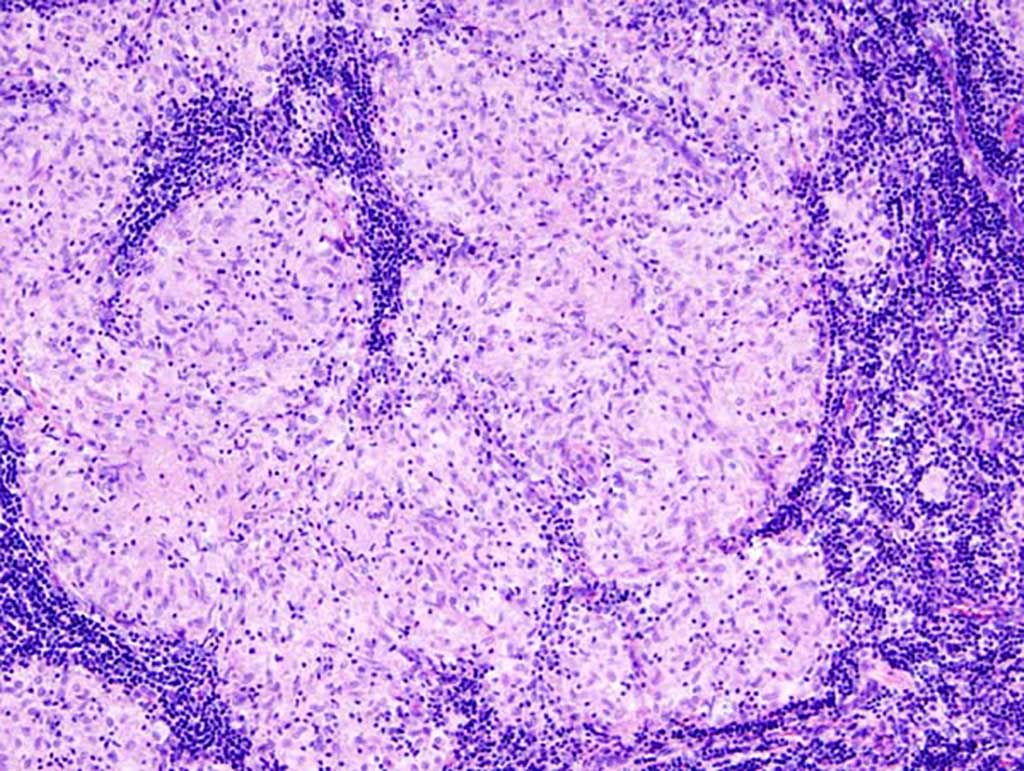Low Lymphocyte Counts Linked to More Severe Sarcoidosis Inflammation
By LabMedica International staff writers
Posted on 09 Mar 2021
A recent paper identified unique phenotypes of sarcoidosis and demonstrated the relationship between these phenotypes and inflammatory activity, as measured by serologic markers of inflammation and avidity on 18FDG-PET/CT scan. Posted on 09 Mar 2021
Sarcoidosis is a systemic inflammatory disease that can affect any organ, although it can be asymptomatic and is discovered by accident in about 5% of cases. Common symptoms, which tend to be vague, include fatigue (unrelieved by sleep; occurs in 66% of cases), lack of energy, weight loss, joint aches and pains (which occur in about 70% of cases), arthritis (14–38% of cases), dry eyes, swelling of the knees, blurry vision, shortness of breath, a dry, hacking cough, or skin lesions.

Image: Histopathological image of sarcoidosis in a lymph node biopsy (Photo courtesy of Wikimedia Commons)
Investigators at the University of Illinois at Chicago (USA) hypothesized that a set of demographic features along with clinically relevant therapeutic, radiographic, and laboratory features would identify subgroups of subjects (clusters) with sarcoidosis at risk of active disease characterized by high levels of inflammation as determined by 18FDG-PET/CT.
Fluorodeoxyglucose F 18 (18F-FDG) is a radiopharmaceutical used in the medical imaging technique positron emission tomography (PET). Chemically, it is 2-deoxy-2-[18F]fluoro-D-glucose, a glucose analog, with the positron-emitting radionuclide fluorine-18 substituted for the normal hydroxyl group at the C-2 position in the glucose molecule. The uptake of 18F-FDG by tissues is a marker for the tissue uptake of glucose, which in turn is closely correlated with certain types of tissue metabolism. After 18F-FDG is injected into a patient, a PET scanner can form two-dimensional or three-dimensional images of the distribution of 18F-FDG within the body.
For this study, the investigators conducted a retrospective study of 58 mainly African American patients who had been diagnosed with sarcoidosis based on biopsy results and who also underwent PET/CT scanning. These patients all had blood tests that included lymphocyte counts.
Results revealed three distinct clusters of patients: (1) a predominantly African American cluster with chronic, quiescent disease, (2) a predominantly African American cluster with elevated conventional inflammatory markers, advanced pulmonary disease and extrathoracic involvement, and (3) a predominantly Caucasian cluster characterized by reduced lymphocyte counts and acute disease. The results also showed that lymphocyte counts could predict levels of inflammation seen on PET/CT scans, with lower lymphocyte levels associated with greater levels of inflammation as picked up on the scans.
"Having a biomarker signature that indicates active inflammation could be very useful in helping guide treatment and for helping us understand the underlying mechanisms associated with the disease," said senior author Dr. Nadera Sweiss, professor of medicine at the University of Illinois at Chicago. "Using measurements of blood lymphocyte levels in combination with PET/CT scans could help guide treatment, since treatment differs for active versus inactive disease states. Our finding represents another tool in our toolbox for guiding treatment of this very variable disease, and helping us learn more about its underlying biology."
The sarcoidosis paper was published in the February 24, 2012, online edition of the journal Frontiers in Medicine.
Related Links:
University of Illinois at Chicago









 Analyzer.jpg)




